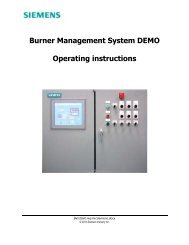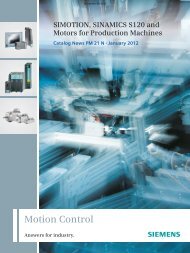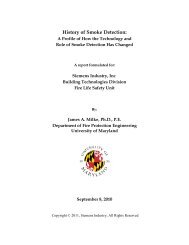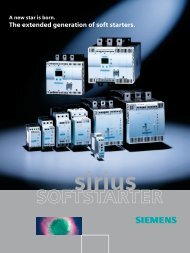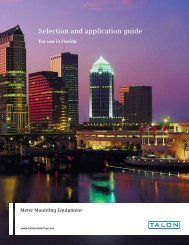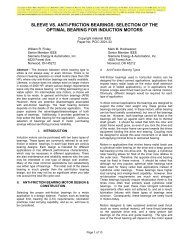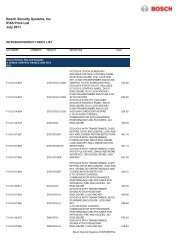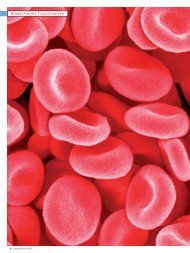Process Automation Systems - Siemens Industry, Inc.
Process Automation Systems - Siemens Industry, Inc.
Process Automation Systems - Siemens Industry, Inc.
Create successful ePaper yourself
Turn your PDF publications into a flip-book with our unique Google optimized e-Paper software.
Glass is tested for proper thickness across its entire width. Any defects are discarded and recycled.<br />
upgrade was in order. He needed a fully<br />
redundant control system with open<br />
communication interfaces and flexibility.<br />
He also wanted a system that would<br />
provide comprehensive and easy-to-use<br />
trending of process data for analysis. But,<br />
above all, reliability topped his selection<br />
criteria.<br />
After evaluating options from a number of<br />
vendors, he chose an integrated<br />
automation and control system from<br />
<strong>Siemens</strong> Energy & <strong>Automation</strong>.<br />
“The redundancy of the <strong>Siemens</strong> PCS 7<br />
system was much better than the other<br />
systems we looked at,” Gehrke says. “That<br />
was one of the main driving forces. We<br />
tested a rack of controllers from <strong>Siemens</strong><br />
as well as the other vendors. There were<br />
fewer steps involved in implementing a<br />
<strong>Siemens</strong> redundant system. If we wanted<br />
to add I/O on the other systems we would<br />
have had to flip ones and zeros. The<br />
<strong>Siemens</strong> system was also very easy to<br />
implement.”<br />
The upgrade solution chosen for the<br />
Menomonie plant was a fully redundant<br />
<strong>Siemens</strong> SIMATIC® PCS 7 control system,<br />
operator station, engineering station,<br />
Masterdrive variable frequency drives,<br />
PROFIBUS I/O, and more than 30 SITRANS<br />
pressure and temperature transmitters. To<br />
take advantage of a digital fieldbus and to<br />
bring it all seamlessly together, Cardinal<br />
Glass replaced the electronics in its<br />
existing analog 4-20 type instruments with<br />
PROFIBUS PA communications capable<br />
modules.<br />
“PROFIBUS helped us eliminate a lot of<br />
manual tweaking at the engineering<br />
station,” Gehrke says. “Also, we chose to<br />
place a controller in each of our production<br />
areas even though we could have used just<br />
one controller for the entire operation. We<br />
chose to keep it broken up because of<br />
redundancy and the ability to isolate<br />
problems.”<br />
Gerhke says a big reason why the<br />
Menomonie plant met its 90-day schedule<br />
for the cold repair was he was able to<br />
retrofit the existing control cabinets with<br />
the new PCS 7 hardware.<br />
“We basically gutted the cabinets and<br />
started over,” Gehrke says “We saved the<br />
wire connections and put terminal blocks<br />
in the bottom. It was the only way we<br />
could have done it on time and on<br />
budget.”<br />
From Batch House to Cutting<br />
The float glass manufacturing process<br />
begins when a precise formulation of eight<br />
raw materials are mixed in the plant’s<br />
batch house. The PCS 7 system<br />
communicates to two S7 417 controllers<br />
(one each for manual operations and<br />
unloading) as well as to a S7 417 H<br />
controller for batching that ensures the<br />
correct amounts of raw materials are<br />
charged into the furnace. At the same<br />
time, cullet (recycled glass) is mixed with<br />
the other raw materials.



